Microservices are good, but can also be an evil if they are not properly conceived. Wrong microservice interpretations could lead to irrecoverable failures.
This chapter will examine the technical challenges around practical implementations of microservices. It will also provide guidelines around critical design decisions for successful microservices development. The solutions and patterns for a number of commonly raised concerns around microservices will also be examined. This chapter will also review the challenges in enterprise scale microservices development, and how to overcome those challenges. More importantly, a capability model for a microservices ecosystem will be established at the end.
In this chapter you will learn about the following:
- Trade-offs between different design choices and patterns to be considered when developing microservices
- Challenges and anti-patterns in developing enterprise grade microservices
- A capability model for a microservices ecosystem
Microservices have gained enormous popularity in recent years. They have evolved as the preferred choice of architects, putting SOA into the backyards. While acknowledging the fact that microservices are a vehicle for developing scalable cloud native systems, successful microservices need to be carefully designed to avoid catastrophes. Microservices are not the one-size-fits-all, universal solution for all architecture problems.
Generally speaking, microservices are a great choice for building a lightweight, modular, scalable, and distributed system of systems. Over-engineering, wrong use cases, and misinterpretations could easily turn the system into a disaster. While selecting the right use cases is paramount in developing a successful microservice, it is equally important to take the right design decisions by carrying out an appropriate trade-off analysis. A number of factors are to be considered when designing microservices, as detailed in the following sections.
One of the most common questions relating to microservices is regarding the size of the service. How big (mini-monolithic) or how small (nano service) can a microservice be, or is there anything like right-sized services? Does size really matter?
A quick answer could be "one REST endpoint per microservice", or "less than 300 lines of code", or "a component that performs a single responsibility". But before we pick up any of these answers, there is lot more analysis to be done to understand the boundaries for our services.
Domain-driven design (DDD) defines the concept of a bounded context. A bounded context is a subdomain or a subsystem of a larger domain or system that is responsible for performing a particular function.
Tip
Read more about DDD at http://domainlanguage.com/ddd/.
The following diagram is an example of the domain model:

In a finance back office, system invoices, accounting, billing, and the like represent different bounded contexts. These bounded contexts are strongly isolated domains that are closely aligned with business capabilities. In the financial domain, the invoices, accounting, and billing are different business capabilities often handled by different subunits under the finance department.
A bounded context is a good way to determine the boundaries of microservices. Each bounded context could be mapped to a single microservice. In the real world, communication between bounded contexts are typically less coupled, and often, disconnected.
Even though real world organizational boundaries are the simplest mechanisms for establishing a bounded context, these may prove wrong in some cases due to inherent problems within the organization's structures. For example, a business capability may be delivered through different channels such as front offices, online, roaming agents, and so on. In many organizations, the business units may be organized based on delivery channels rather than the actual underlying business capabilities. In such cases, organization boundaries may not provide accurate service boundaries.
A top-down domain decomposition could be another way to establish the right bounded contexts.
There is no silver bullet to establish microservices boundaries, and often, this is quite challenging. Establishing boundaries is much easier in the scenario of monolithic application to microservices migration, as the service boundaries and dependencies are known from the existing system. On the other hand, in a green field microservices development, the dependencies are hard to establish upfront.
The most pragmatic way to design microservices boundaries is to run the scenario at hand through a number of possible options, just like a service litmus test. Keep in mind that there may be multiple conditions matching a given scenario that will lead to a trade-off analysis.
The following scenarios could help in defining the microservice boundaries.
If the function under review is autonomous by nature, then it can be taken as a microservices boundary. Autonomous services typically would have fewer dependencies on external functions. They accept input, use its internal logic and data for computation, and return a result. All utility functions such as an encryption engine or a notification engine are straightforward candidates.
A delivery service that accepts an order, processes it, and then informs the trucking service is another example of an autonomous service. An online flight search based on cached seat availability information is yet another example of an autonomous function.
Most of the microservices ecosystems will take advantage of automation, such as automatic integration, delivery, deployment, and scaling. Microservices covering broader functions result in larger deployment units. Large deployment units pose challenges in automatic file copy, file download, deployment, and start up times. For instance, the size of a service increases with the density of the functions that it implements.
A good microservice ensures that the size of its deployable units remains manageable.
It is important to analyze what would be the most useful component to detach from the monolithic application. This is particularly applicable when breaking monolithic applications into microservices. This could be based on parameters such as resource-intensiveness, cost of ownership, business benefits, or flexibility.
In a typical hotel booking system, approximately 50-60% of the requests are search-based. In this case, moving out the search function could immediately bring in flexibility, business benefits, cost reduction, resource free up, and so on.
One of the key characteristics of microservices is its support for polyglot architecture. In order to meet different non-functional and functional requirements, components may require different treatments. It could be different architectures, different technologies, different deployment topologies, and so on. When components are identified, review them against the requirement for polyglot architectures.
In the hotel booking scenario mentioned earlier, a Booking microservice may need transactional integrity, whereas a Search microservice may not. In this case, the Booking microservice may use an ACID compliance database such as MySQL, whereas the Search microservice may use an eventual consistent database such as Cassandra.
Selective scaling is related to the previously discussed polyglot architecture. In this context, all functional modules may not require the same level of scalability. Sometimes, it may be appropriate to determine boundaries based on scalability requirements.
For example, in the hotel booking scenario, the Search microservice has to scale considerably more than many of the other services such as the Booking microservice or the Notification microservice due to the higher velocity of search requests. In this case, a separate Search microservice could run on top of an Elasticsearch or an in-memory data grid for better response.
Microservices enable Agile development with small, focused teams developing different parts of the pie. There could be scenarios where parts of the systems are built by different organizations, or even across different geographies, or by teams with varying skill sets. This approach is a common practice, for example, in manufacturing industries.
In the microservices world, each of these teams builds different microservices, and then assembles them together. Though this is not the desired way to break down the system, organizations may end up in such situations. Hence, this approach cannot be completely ruled out.
In an online product search scenario, a service could provide personalized options based on what the customer is looking for. This may require complex machine learning algorithms, and hence need a specialist team. In this scenario, this function could be built as a microservice by a separate specialist team.
In theory, the single responsibility principle could be applied at a method, at a class, or at a service. However, in the context of microservices, it does not necessarily map to a single service or endpoint.
A more practical approach could be to translate single responsibility into single business capability or a single technical capability. As per the single responsibility principle, one responsibility cannot be shared by multiple microservices. Similarly, one microservice should not perform multiple responsibilities.
There could, however, be special cases where a single business capability is divided across multiple services. One of such cases is managing the customer profile, where there could be situations where you may use two different microservices for managing reads and writes using a Command Query Responsibility Segregation (CQRS) approach to achieve some of the quality attributes.
Innovation and speed are of the utmost importance in IT delivery. Microservices boundaries should be identified in such a way that each microservice is easily detachable from the overall system, with minimal cost of re-writing. If part of the system is just an experiment, it should ideally be isolated as a microservice.
An organization may develop a recommendation engine or a customer ranking engine as an experiment. If the business value is not realized, then throw away that service, or replace it with another one.
Many organizations follow the startup model, where importance is given to meeting functions and quick delivery. These organizations may not worry too much about the architecture and technologies. Instead, the focus will be on what tools or technologies can deliver solutions faster. Organizations increasingly choose the approach of developing Minimum Viable Products (MVPs) by putting together a few services, and allowing the system to evolve. Microservices play a vital role in such cases where the system evolves, and services gradually get rewritten or replaced.
Coupling and cohesion are two of the most important parameters for deciding service boundaries. Dependencies between microservices have to be evaluated carefully to avoid highly coupled interfaces. A functional decomposition, together with a modeled dependency tree, could help in establishing a microservices boundary. Avoiding too chatty services, too many synchronous request-response calls, and cyclic synchronous dependencies are three key points, as these could easily break the system. A successful equation is to keep high cohesion within a microservice, and loose coupling between microservices. In addition to this, ensure that transaction boundaries are not stretched across microservices. A first class microservice will react upon receiving an event as an input, execute a number of internal functions, and finally send out another event. As part of the compute function, it may read and write data to its own local store.
DDD also recommends mapping a bounded context to a product. As per DDD, each bounded context is an ideal candidate for a product. Think about a microservice as a product by itself. When microservice boundaries are established, assess them from a product's point of view to see whether they really stack up as product. It is much easier for business users to think boundaries from a product point of view. A product boundary may have many parameters, such as a targeted community, flexibility in deployment, sell-ability, reusability, and so on.
Communication between microservices can be designed either in synchronous (request-response) or asynchronous (fire and forget) styles.
The following diagram shows an example request/response style service:
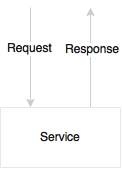
In synchronous communication, there is no shared state or object. When a caller requests a service, it passes the required information and waits for a response. This approach has a number of advantages.
An application is stateless, and from a high availability standpoint, many active instances can be up and running, accepting traffic. Since there are no other infrastructure dependencies such as a shared messaging server, there are management fewer overheads. In case of an error at any stage, the error will be propagated back to the caller immediately, leaving the system in a consistent state, without compromising data integrity.
The downside in a synchronous request-response communication is that the user or the caller has to wait until the requested process gets completed. As a result, the calling thread will wait for a response, and hence, this style could limit the scalability of the system.
A synchronous style adds hard dependencies between microservices. If one service in the service chain fails, then the entire service chain will fail. In order for a service to succeed, all dependent services have to be up and running. Many of the failure scenarios have to be handled using timeouts and loops.
The following diagram is a service designed to accept an asynchronous message as input, and send the response asynchronously for others to consume:

The asynchronous style is based on reactive event loop semantics which decouple microservices. This approach provides higher levels of scalability, because services are independent, and can internally spawn threads to handle an increase in load. When overloaded, messages will be queued in a messaging server for later processing. That means that if there is a slowdown in one of the services, it will not impact the entire chain. This provides higher levels of decoupling between services, and therefore maintenance and testing will be simpler.
The downside is that it has a dependency to an external messaging server. It is complex to handle the fault tolerance of a messaging server. Messaging typically works with an active/passive semantics. Hence, handling continuous availability of messaging systems is harder to achieve. Since messaging typically uses persistence, a higher level of I/O handling and tuning is required.
Both approaches have their own merits and constraints. It is not possible to develop a system with just one approach. A combination of both approaches is required based on the use cases. In principle, the asynchronous approach is great for building true, scalable microservice systems. However, attempting to model everything as asynchronous leads to complex system designs.
How does the following example look in the context where an end user clicks on a UI to get profile details?
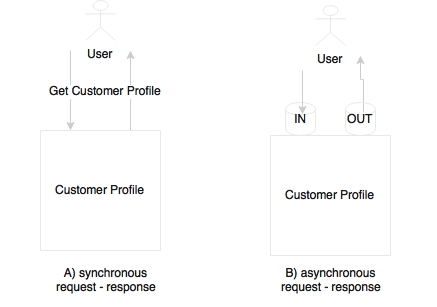
This is perhaps a simple query to the backend system to get a result in a request-response model. This can also be modeled in an asynchronous style by pushing a message to an input queue, and waiting for a response in an output queue till a response is received for the given correlation ID. However, though we use asynchronous messaging, the user is still blocked for the entire duration of the query.
Another use case is that of a user clicking on a UI to search hotels, which is depicted in the following diagram:
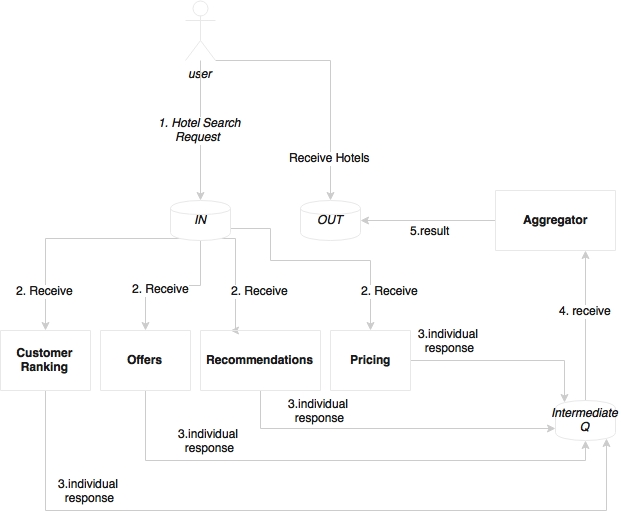
This is very similar to the previous scenario. However, in this case, we assume that this business function triggers a number of activities internally before returning the list of hotels back to the user. For example, when the system receives this request, it calculates the customer ranking, gets offers based on the destination, gets recommendations based on customer preferences, optimizes the prices based on customer values and revenue factors, and so on. In this case, we have an opportunity to do many of these activities in parallel so that we can aggregate all these results before presenting them to the customer. As shown in the preceding diagram, virtually any computational logic could be plugged in to the search pipeline listening to the IN queue.
An effective approach in this case is to start with a synchronous request response, and refactor later to introduce an asynchronous style when there is value in doing that.
The following example shows a fully asynchronous style of service interactions:
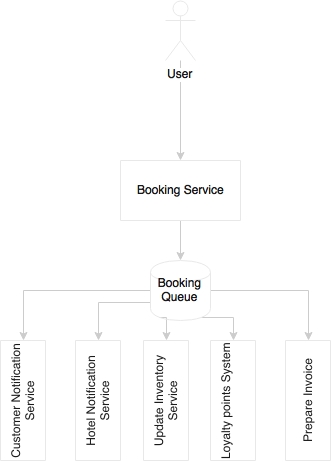
The service is triggered when the user clicks on the booking function. It is again, by nature, a synchronous style communication. When booking is successful, it sends a message to the customer's e-mail address, sends a message to the hotel's booking system, updates the cached inventory, updates the loyalty points system, prepares an invoice, and perhaps more. Instead of pushing the user into a long wait state, a better approach is to break the service into pieces. Let the user wait till a booking record is created by the Booking Service. On successful completion, a booking event will be published, and return a confirmation message back to the user. Subsequently, all other activities will happen in parallel, asynchronously.
In all three examples, the user has to wait for a response. With the new web application frameworks, it is possible to send requests asynchronously, and define the callback method, or set an observer for getting a response. Therefore, the users won't be fully blocked from executing other activities.
In general, an asynchronous style is always better in the microservices world, but identifying the right pattern should be purely based on merits. If there are no merits in modeling a transaction in an asynchronous style, then use the synchronous style till you find an appealing case. Use reactive programming frameworks to avoid complexity when modeling user-driven requests, modeled in an asynchronous style.
Composability is one of the service design principles. This leads to confusion around who is responsible for the composing services. In the SOA world, ESBs are responsible for composing a set of finely-grained services. In some organizations, ESBs play the role of a proxy, and service providers themselves compose and expose coarse-grained services. In the SOA world, there are two approaches for handling such situations.
The first approach is orchestration, which is depicted in the following diagram:

In the orchestration approach, multiple services are stitched together to get a complete function. A central brain acts as the orchestrator. As shown in the diagram, the order service is a composite service that will orchestrate other services. There could be sequential as well as parallel branches from the master process. Each task will be fulfilled by an atomic task service, typically a web service. In the SOA world, ESBs play the role of orchestration. The orchestrated service will be exposed by ESBs as a composite service.
The second approach is choreography, which is shown in the following diagram:

In the choreography approach, there is no central brain. An event, a booking event in this case, is published by a producer, a number of consumers wait for the event, and independently apply different logics on the incoming event. Sometimes, events could even be nested where the consumers can send another event which will be consumed by another service. In the SOA world, the caller pushes a message to the ESB, and the downstream flow will be automatically determined by the consuming services.
Microservices are autonomous. This essentially means that in an ideal situation, all required components to complete their function should be within the service. This includes the database, orchestration of its internal services, intrinsic state management, and so on. The service endpoints provide coarse-grained APIs. This is perfectly fine as long as there are no external touch points required. But in reality, microservices may need to talk to other microservices to fulfil their function.
In such cases, choreography is the preferred approach for connecting multiple microservices together. Following the autonomy principle, a component sitting outside a microservice and controlling the flow is not the desired option. If the use case can be modeled in choreographic style, that would be the best possible way to handle the situation.
But it may not be possible to model choreography in all cases. This is depicted in the following diagram:
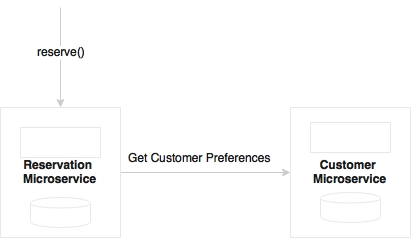
In the preceding example, Reservation and Customer are two microservices, with clearly segregated functional responsibilities. A case could arise when Reservation would want to get Customer preferences while creating a reservation. These are quite normal scenarios when developing complex systems.
Can we move Customer to Reservation so that Reservation will be complete by itself? If Customer and Reservation are identified as two microservices based on various factors, it may not be a good idea to move Customer to Reservation. In such a case, we will meet another monolithic application sooner or later.
Can we make the Reservation to Customer call asynchronous? This example is shown in the following diagram:
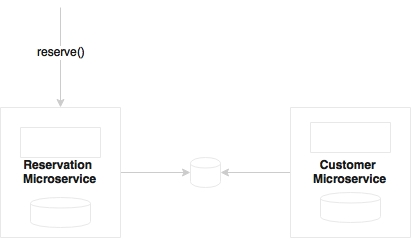
Customer preference is required for Reservation to progress, and hence, it may require a synchronous blocking call to Customer. Retrofitting this by modeling asynchronously does not really make sense.
Can we take out just the orchestration bit, and create another composite microservice, which then composes Reservation and Customer?
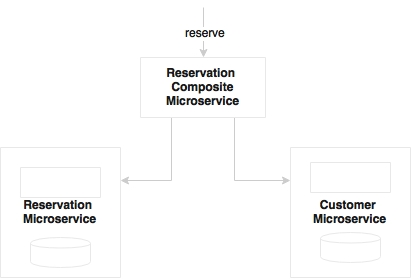
This is acceptable in the approach for composing multiple components within a microservice. But creating a composite microservice may not be a good idea. We will end up creating many microservices with no business alignment, which would not be autonomous, and could result in many fine-grained microservices.
Can we duplicate customer preference by keeping a slave copy of the preference data into Reservation?
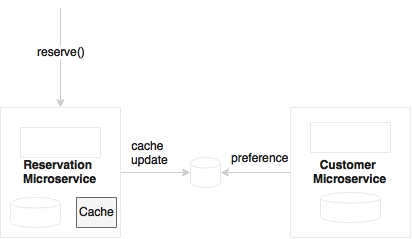
Changes will be propagated whenever there is a change in the master. In this case, Reservation can use customer preference without fanning out a call. It is a valid thought, but we need to carefully analyze this. Today we replicate customer preference, but in another scenario, we may want to reach out to customer service to see whether the customer is black-listed from reserving. We have to be extremely careful in deciding what data to duplicate. This could add to the complexity.
In many situations, developers are confused with the number of endpoints per microservice. The question really is whether to limit each microservice with one endpoint or multiple endpoints:
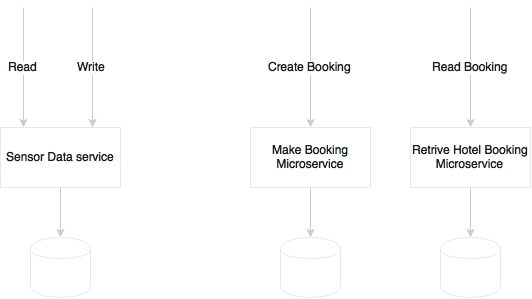
The number of endpoints is not really a decision point. In some cases, there may be only one endpoint, whereas in some other cases, there could be more than one endpoint in a microservice. For instance, consider a sensor data service which collects sensor information, and has two logical endpoints: create and read. But in order to handle CQRS, we may create two separate physical microservices as shown in the case of Booking in the preceding diagram. Polyglot architecture could be another scenario where we may split endpoints into different microservices.
Considering a notification engine, notifications will be send out in response to an event. The process of notification such as preparation of data, identification of a person, and delivery mechanisms, are different for different events. Moreover, we may want to scale each of these processes differently at different time windows. In such situations, we may decide to break each notification endpoint in to a separate microservice.
In yet another example, a Loyalty Points microservice may have multiple services such as accrue, redeem, transfer, and balance. We may not want to treat each of these services differently. All of these services are connected and use the points table for data. If we go with one endpoint per service, we will end up in a situation where many fine-grained services access data from the same data store or replicated copies of the same data store.
In short, the number of endpoints is not a design decision. One microservice may host one or more endpoints. Designing appropriate bounded context for a microservice is more important.
One microservice could be deployed in multiple Virtual Machines (VMs) by replicating the deployment for scalability and availability. This is a no brainer. The question is whether multiple microservices could be deployed in one virtual machine? There are pros and cons for this approach. This question typically arises when the services are simple, and the traffic volume is less.
Consider an example where we have a couple of microservices, and the overall transaction per minute is less than 10. Also assume that the smallest possible VM size available is 2-core 8 GB RAM. A further assumption is that in such cases, a 2-core 8 GB VM can handle 10-15 transactions per minute without any performance concerns. If we use different VMs for each microservice, it may not be cost effective, and we will end up paying more for infrastructure and license, since many vendors charge based on the number of cores.
The simplest way to approach this problem is to ask a few questions:
- Does the VM have enough capacity to run both services under peak usage?
- Do we want to treat these services differently to achieve SLAs (selective scaling)? For example, for scalability, if we have an all-in-one VM, we will have to replicate VMs which replicate all services.
- Are there any conflicting resource requirements? For example, different OS versions, JDK versions, and others.
If all your answers are No, then perhaps we can start with collocated deployment, until we encounter a scenario to change the deployment topology. However, we will have to ensure that these services are not sharing anything, and are running as independent OS processes.
Having said that, in an organization with matured virtualized infrastructure or cloud infrastructure, this may not be a huge concern. In such environments, the developers need not worry about where the services are running. Developers may not even think about capacity planning. Services will be deployed in a compute cloud. Based on the infrastructure availability, SLAs and the nature of the service, the infrastructure self-manages deployments. AWS Lambda is a good example of such a service.
Rules are an essential part of any system. For example, an offer eligibility service may execute a number of rules before making a yes or no decision. Either we hand code rules, or we may use a rules engine. Many enterprises manage rules centrally in a rules repository as well as execute them centrally. These enterprise rule engines are primarily used for providing the business an opportunity to author and manage rules as well as reuse rules from the central repository. Drools is one of the popular open source rules engines. IBM, FICO, and Bosch are some of the pioneers in the commercial space. These rule engines improve productivity, enable reuse of rules, facts, vocabularies, and provide faster rule execution using the rete algorithm.
In the context of microservices, a central rules engine means fanning out calls from microservices to the central rules engine. This also means that the service logic is now in two places, some within the service, and some external to the service. Nevertheless, the objective in the context of microservices is to reduce external dependencies:
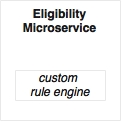
If the rules are simple enough, few in numbers, only used within the boundaries of a service, and not exposed to business users for authoring, then it may be better to hand-code business rules than rely on an enterprise rule engine:
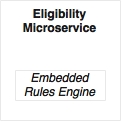
If the rules are complex, limited to a service context, and not given to business users, then it is better to use an embedded rules engine within the service:
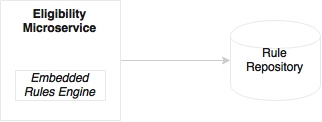
If the rules are managed and authored by business, or if the rules are complex, or if we are reusing rules from other service domains, then a central authoring repository with a locally embedded execution engine could be a better choice.
Note that this has to be carefully evaluated since all vendors may not support the local rule execution approach, and there could be technology dependencies such as running rules only within a specific application server, and so on.
Business Process Management (BPM) and Intelligent Business Process Management (iBPM) are tool suites for designing, executing, and monitoring business processes.
Typical use cases for BPM are:
- Coordinating a long-running business process, where some processes are realized by existing assets, whereas some other areas may be niche, and there is no concrete implementation of the processes being in place. BPM allows composing both types, and provides an end-to-end automated process. This often involves systems and human interactions.
- Process-centric organizations, such as those that have implemented Six Sigma, want to monitor their processes for continuous improvement on efficiency.
- Process re-engineering with a top-down approach by redefining the business process of an organization.
There could be two scenarios where BPM fits in the microservices world:

The first scenario is business process re-engineering, or threading an end-to-end long running business process, as stated earlier. In this case, BPM operates at a higher level, where it may automate a cross-functional, long-running business process by stitching a number of coarse-grained microservices, existing legacy connectors, and human interactions. As shown in the preceding diagram, the loan approval BPM invokes microservices as well as legacy application services. It also integrates human tasks.
In this case, microservices are headless services that implement a subprocess. From the microservices' perspective, BPM is just another consumer. Care needs to be taken in this approach to avoid accepting a shared state from a BPM process as well as moving business logic to BPM:
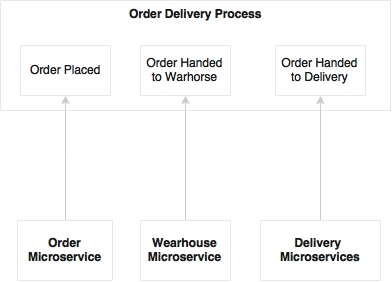
The second scenario is monitoring processes, and optimizing them for efficiency. This goes hand in hand with a completely automated, asynchronously choreographed microservices ecosystem. In this case, microservices and BPM work as independent ecosystems. Microservices send events at various timeframes such as the start of a process, state changes, end of a process, and so on. These events are used by the BPM engine to plot and monitor process states. We may not require a full-fledged BPM solution for this, as we are only mocking a business process to monitor its efficiency. In this case, the order delivery process is not a BPM implementation, but it is more of a monitoring dashboard that captures and displays the progress of the process.
To summarize, BPM could still be used at a higher level for composing multiple microservices in situations where end-to-end cross-functional business processes are modeled by automating systems and human interactions. A better and simpler approach is to have a business process dashboard to which microservices feed state change events as mentioned in the second scenario.
In principle, microservices should abstract presentation, business logic, and data stores. If the services are broken as per the guidelines, each microservice logically could use an independent database:
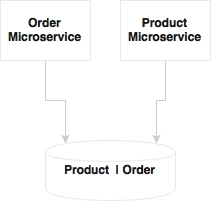
In the preceding diagram, both Product and Order microservices share one database and one data model. Shared data models, shared schema, and shared tables are recipes for disasters when developing microservices. This may be good at the beginning, but when developing complex microservices, we tend to add relationships between data models, add join queries, and so on. This can result in tightly coupled physical data models.
If the services have only a few tables, it may not be worth investing a full instance of a database like an Oracle database instance. In such cases, a schema level segregation is good enough to start with:
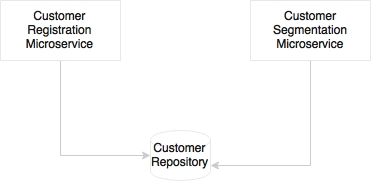
There could be scenarios where we tend to think of using a shared database for multiple services. Taking an example of a customer data repository or master data managed at the enterprise level, the customer registration and customer segmentation microservices logically share the same customer data repository:
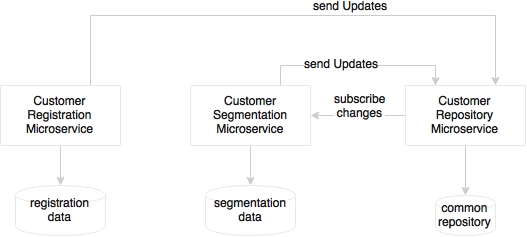
As shown in the preceding diagram, an alternate approach in this scenario is to separate the transactional data store for microservices from the enterprise data repository by adding a local transactional data store for these services. This will help the services to have flexibility in remodeling the local data store optimized for its purpose. The enterprise customer repository sends change events when there is any change in the customer data repository. Similarly, if there is any change in any of the transactional data stores, the changes have to be sent to the central customer repository.
Transactions in operational systems are used to maintain the consistency of data stored in an RDBMS by grouping a number of operations together into one atomic block. They either commit or rollback the entire operation. Distributed systems follow the concept of distributed transactions with a two-phase commit. This is particularly required if heterogeneous components such as an RPC service, JMS, and so on participate in a transaction.
Is there a place for transactions in microservices? Transactions are not bad, but one should use transactions carefully, by analyzing what we are trying do.
For a given microservice, an RDBMS like MySQL may be selected as a backing store to ensure 100% data integrity, for example, a stock or inventory management service where data integrity is key. It is appropriate to define transaction boundaries within the microsystem using local transactions. However, distributed global transactions should be avoided in the microservices context. Proper dependency analysis is required to ensure that transaction boundaries do not span across two different microservices as much as possible.
Eventual consistency is a better option than distributed transactions that span across multiple microservices. Eventual consistency reduces a lot of overheads, but application developers may need to re-think the way they write application code. This could include remodeling functions, sequencing operations to minimize failures, batching insert and modify operations, remodeling data structure, and finally, compensating operations that negate the effect.
A classical problem is that of the last room selling scenario in a hotel booking use case. What if there is only one room left, and there are multiple customers booking this singe available room? A business model change sometimes makes this scenario less impactful. We could set an "under booking profile", where the actual number of bookable rooms can go below the actual number of rooms (bookable = available - 3) in anticipation of some cancellations. Anything in this range will be accepted as "subject to confirmation", and customers will be charged only if payment is confirmed. Bookings will be confirmed in a set time window.
Now consider the scenario where we are creating customer profiles in a NoSQL database like CouchDB. In more traditional approaches with RDBMS, we insert a customer first, and then insert the customer's address, profile details, then preferences, all in one transaction. When using NoSQL, we may not do the same steps. Instead, we may prepare a JSON object with all the details, and insert this into CouchDB in one go. In this second case, no explicit transaction boundaries are required.
The ideal scenario is to use local transactions within a microservice if required, and completely avoid distributed transactions. There could be scenarios where at the end of the execution of one service, we may want to send a message to another microservice. For example, say a tour reservation has a wheelchair request. Once the reservation is successful, we will have to send a message for the wheelchair booking to another microservice that handles ancillary bookings. The reservation request itself will run on a local transaction. If sending this message fails, we are still in the transaction boundary, and we can roll back the entire transaction. What if we create a reservation and send the message, but after sending the message, we encounter an error in the reservation, the reservation transaction fails, and subsequently, the reservation record is rolled back? Now we end up in a situation where we've unnecessarily created an orphan wheelchair booking:
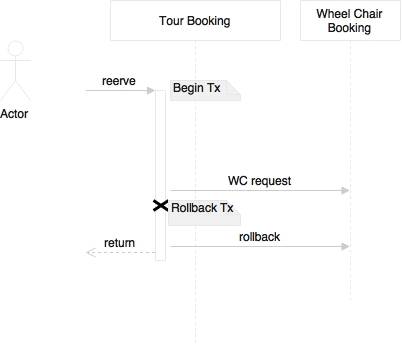
There are a couple of ways we can address this scenario. The first approach is to delay sending the message till the end. This ensures that there are less chances for any failure after sending the message. Still, if failure occurs after sending the message, then the exception handling routine is run, that is, we send a compensating message to reverse the wheelchair booking.
One of the important aspects of microservices is service design. Service design has two key elements: contract design and protocol selection.
The first and foremost principle of service design is simplicity. The services should be designed for consumers to consume. A complex service contract reduces the usability of the service. The KISS (Keep It Simple Stupid) principle helps us to build better quality services faster, and reduces the cost of maintenance and replacement. The YAGNI (You Ain't Gonna Need It) is another principle supporting this idea. Predicting future requirements and building systems are, in reality, not future-proofed. This results in large upfront investment as well as higher cost of maintenance.
Evolutionary design is a great concept. Do just enough design to satisfy today's wants, and keep changing and refactoring the design to accommodate new features as and when they are required. Having said that, this may not be simple unless there is a strong governance in place.
Consumer Driven Contracts (CDC) is a great idea that supports evolutionary design. In many cases, when the service contract gets changed, all consuming applications have to undergo testing. This makes change difficult. CDC helps in building confidence in consumer applications. CDC advocates each consumer to provide their expectation to the provider in the form of test cases so that the provider uses them as integration tests whenever the service contract is changed.
Postel's law is also relevant in this scenario. Postel's law primarily addresses TCP communications; however, this is also equally applicable to service design. When it comes to service design, service providers should be as flexible as possible when accepting consumer requests, whereas service consumers should stick to the contract as agreed with the provider.
In the SOA world, HTTP/SOAP, and messaging were kinds of default service protocols for service interactions. Microservices follow the same design principles for service interaction. Loose coupling is one of the core principles in the microservices world too.
Microservices fragment applications into many physically independent deployable services. This not only increases the communication cost, it is also susceptible to network failures. This could also result in poor performance of services.
If we choose an asynchronous style of communication, the user is disconnected, and therefore, response times are not directly impacted. In such cases, we may use standard JMS or AMQP protocols for communication with JSON as payload. Messaging over HTTP is also popular, as it reduces complexity. Many new entrants in messaging services support HTTP-based communication. Asynchronous REST is also possible, and is handy when calling long-running services.
Communication over HTTP is always better for interoperability, protocol handling, traffic routing, load balancing, security systems, and the like. Since HTTP is stateless, it is more compatible for handling stateless services with no affinity. Most of the development frameworks, testing tools, runtime containers, security systems, and so on are friendlier towards HTTP.
With the popularity and acceptance of REST and JSON, it is the default choice for microservice developers. The HTTP/REST/JSON protocol stack makes building interoperable systems very easy and friendly. HATEOAS is one of the design patterns emerging for designing progressive rendering and self-service navigations. As discussed in the previous chapter, HATEOAS provides a mechanism to link resources together so that the consumer can navigate between resources. RFC 5988 – Web Linking is another upcoming standard.
If the service response times are stringent, then we need to pay special attention to the communication aspects. In such cases, we may choose alternate protocols such as Avro, Protocol Buffers, or Thrift for communicating between services. But this limits the interoperability of services. The trade-off is between performance and interoperability requirements. Custom binary protocols need careful evaluation as they bind native objects on both sides—consumer and producer. This could run into release management issues such as class version mismatch in Java-based RPC style communications.
The principle behind microservices is that they should be autonomous and self-contained. In order to adhere to this principle, there may be situations where we will have to duplicate code and libraries. These could be either technical libraries or functional components.

For example, the eligibility for a flight upgrade will be checked at the time of check-in as well as when boarding. If check-in and boarding are two different microservices, we may have to duplicate the eligibility rules in both the services. This was the trade-off between adding a dependency versus code duplication.
It may be easy to embed code as compared to adding an additional dependency, as it enables better release management and performance. But this is against the DRY principle.
The downside of this approach is that in case of a bug or an enhancement on the shared library, it has to be upgraded in more than one place. This may not be a severe setback as each service can contain a different version of the shared library:

An alternative option of developing the shared library as another microservice itself needs careful analysis. If it is not qualified as a microservice from the business capability point of view, then it may add more complexity than its usefulness. The trade-off analysis is between overheads in communication versus duplicating the libraries in multiple services.
The microservices principle advocates a microservice as a vertical slice from the database to presentation:

In reality, we get requirements to build quick UI and mobile applications mashing up the existing APIs. This is not uncommon in the modern scenario, where a business wants quick turnaround time from IT:
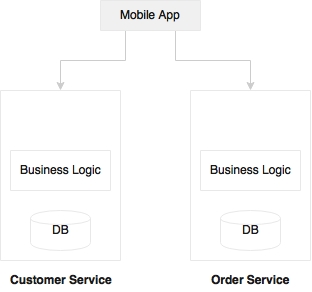
Penetration of mobile applications is one of the causes of this approach. In many organizations, there will be mobile development teams sitting close to the business team, developing rapid mobile applications by combining and mashing up APIs from multiple sources, both internal and external. In such situations, we may just expose services, and leave it for the mobile teams to realize in the way the business wants. In this case, we will build headless microservices, and leave it to the mobile teams to build a presentation layer.
Another category of problem is that the business may want to build consolidated web applications targeted to communities:
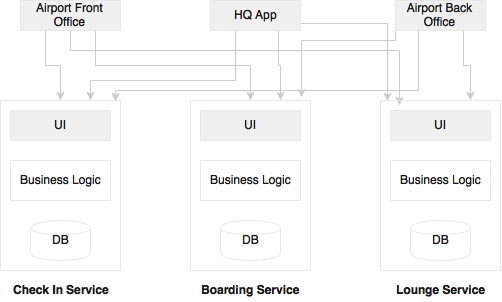
For example, the business may want to develop a departure control application targeting airport users. A departure control web application may have functions such as check-in, lounge management, boarding, and so on. These may be designed as independent microservices. But from the business standpoint, it all needs to be clubbed into a single web application. In such cases, we will have to build web applications by mashing up services from the backend.
One approach is to build a container web application or a placeholder web application, which links to multiple microservices at the backend. In this case, we develop full stack microservices, but the screens coming out of this could be embedded in to another placeholder web application. One of the advantages of this approach is that you can have multiple placeholder web applications targeting different user communities, as shown in the preceding diagram. We may use an API gateway to avoid those crisscross connections. We will explore the API gateway in the next section.
With the advancement of client-side JavaScript frameworks like AngularJS, the server is expected to expose RESTful services. This could lead to two issues. The first issue is the mismatch in contract expectations. The second issue is multiple calls to the server to render a page.
We start with the contract mismatch case. For example, GetCustomer may return a JSON with many fields:
Customer {
Name:
Address:
Contact:
}In the preceding case, Name, Address, and Contact are nested JSON objects. But a mobile client may expect only basic information such as first name, and last name. In the SOA world, an ESB or a mobile middleware did this job of transformation of data for the client. The default approach in microservices is to get all the elements of Customer, and then the client takes up the responsibility to filter the elements. In this case, the overhead is on the network.
There are several approaches we can think about to solve this case:
Customer {
Id: 1
Name: /customer/name/1
Address: /customer/address/1
Contact: /customer/contact/1
}In the first approach, minimal information is sent with links as explained in the section on HATEOAS. In the preceding case, for customer ID 1, there are three links, which will help the client to access specific data elements. The example is a simple logical representation, not the actual JSON. The mobile client in this case will get basic customer information. The client further uses the links to get the additional required information.
The second approach is used when the client makes the REST call; it also sends the required fields as part of the query string. In this scenario, the client sends a request with firstname and lastname as the query string to indicate that the client only requires these two fields. The downside is that it ends up in complex server-side logic as it has to filter based on the fields. The server has to send different elements based on the incoming query.
The third approach is to introduce a level of indirection. In this, a gateway component sits between the client and the server, and transforms data as per the consumer's specification. This is a better approach as we do not compromise on the backend service contract. This leads to what is called UI services. In many cases, the API gateway acts as a proxy to the backend, exposing a set of consumer-specific APIs:

There are two ways we can deploy an API gateway. The first one is one API gateway per microservice as shown in diagram A. The second approach (diagram B) is to have a common API gateway for multiple services. The choice really depends on what we are looking for. If we are using an API gateway as a reverse proxy, then off-the-shelf gateways such as Apigee, Mashery, and the like could be used as a shared platform. If we need fine-grained control over traffic shaping and complex transformations, then per service custom API gateways may be more useful.
A related problem is that we will have to make many calls from the client to the server. If we refer to our holiday example in Chapter 1, Demystifying Microservices, you know that for rendering each widget, we had to make a call to the server. Though we transfer only data, it can still add a significant overhead on the network. This approach is not fully wrong, as in many cases, we use responsive design and progressive design. The data will be loaded on demand, based on user navigations. In order to do this, each widget in the client should make independent calls to the server in a lazy mode. If bandwidth is an issue, then an API gateway is the solution. An API gateway acts as a middleman to compose and transform APIs from multiple microservices.
Theoretically, SOA is not all about ESBs, but the reality is that ESBs have always been at the center of many SOA implementations. What would be the role of an ESB in the microservices world?
In general, microservices are fully cloud native systems with smaller footprints. The lightweight characteristics of microservices enable automation of deployments, scaling, and so on. On the contrary, enterprise ESBs are heavyweight in nature, and most of the commercial ESBs are not cloud friendly. The key features of an ESB are protocol mediation, transformation, orchestration, and application adaptors. In a typical microservices ecosystem, we may not need any of these features.
The limited ESB capabilities that are relevant for microservices are already available with more lightweight tools such as an API gateway. Orchestration is moved from the central bus to the microservices themselves. Therefore, there is no centralized orchestration capability expected in the case of microservices. Since the services are set up to accept more universal message exchange styles using REST/JSON calls, no protocol mediation is required. The last piece of capability that we get from ESBs are the adaptors to connect back to the legacy systems. In the case of microservices, the service itself provides a concrete implementation, and hence, there are no legacy connectors required. For these reasons, there is no natural space for ESBs in the microservices world.
Many organizations established ESBs as the backbone for their application integrations (EAI). Enterprise architecture policies in such organizations are built around ESBs. There could be a number of enterprise-level policies such as auditing, logging, security, validation, and so on that would have been in place when integrating using ESB. Microservices, however, advocate a more decentralized governance. ESBs will be an overkill if integrated with microservices.
Not all services are microservices. Enterprises have legacy applications, vendor applications, and so on. Legacy services use ESBs to connect with microservices. ESBs still hold their place for legacy integration and vendor applications to integrate at the enterprise level.
With the advancement of clouds, the capabilities of ESBs are not sufficient to manage integration between clouds, cloud to on-premise, and so on. Integration Platform as a Service (iPaaS) is evolving as the next generation application integration platform, which further reduces the role of ESBs. In typical deployments, iPaaS invokes API gateways to access microservices.
When we allow services to evolve, one of the important aspect to consider is service versioning. Service versioning should be considered upfront, and not as an afterthought. Versioning helps us to release new services without breaking the existing consumers. Both the old version and the new version will be deployed side by side.
Semantic versions are widely used for service versioning. A semantic version has three components: major, minor, and patch. Major is used when there is a breaking change, minor is used when there is a backward compatible change, and patch is used when there is a backward compatible bug fix.
Versioning could get complicated when there is more than one service in a microservice. It is always simple to version services at the service level compared to the operations level. If there is a change in one of the operations, the service is upgraded and deployed to V2. The version change is applicable to all operations in the service. This is the notion of immutable services.
There are three different ways in which we can version REST services:
- URI versioning
- Media type versioning
- Custom header
In URI versioning, the version number is included in the URL itself. In this case, we just need to be worried about the major versions only. Hence, if there is a minor version change or a patch, the consumers do not need to worry about the changes. It is a good practice to alias the latest version to a non-versioned URI, which is done as follows:
/api/v3/customer/1234
/api/customer/1234 - aliased to v3.
@RestController("CustomerControllerV3")
@RequestMapping("api/v3/customer")
public class CustomerController {
}A slightly different approach is to use the version number as part of the URL parameter:
api/customer/100?v=1.5
In case of media type versioning, the version is set by the client on the HTTP Accept header as follows:
Accept: application/vnd.company.customer-v3+json
A less effective approach for versioning is to set the version in the custom header:
@RequestMapping(value = "/{id}", method = RequestMethod.GET, headers = {"version=3"})
public Customer getCustomer(@PathVariable("id") long id) {
//other code goes here.
}In the URI approach, it is simple for the clients to consume services. But this has some inherent issues such as the fact that versioning-nested URI resources could be complex. Indeed, migrating clients is slightly complex as compared to media type approaches, with caching issues for multiple versions of the services, and others. However, these issues are not significant enough for us to not go with a URI approach. Most of the big Internet players such as Google, Twitter, LinkedIn, and Salesforce are following the URI approach.
With microservices, there is no guarantee that the services will run from the same host or same domain. Composite UI web applications may call multiple microservices for accomplishing a task, and these could come from different domains and hosts.
CORS allows browser clients to send requests to services hosted on different domains. This is essential in a microservices-based architecture.
One approach is to enable all microservices to allow cross origin requests from other trusted domains. The second approach is to use an API gateway as a single trusted domain for the clients.
When breaking large applications, one of the common issues which we see is the management of master data or reference data. Reference data is more like shared data required between different microservices. City master, country master, and so on will be used in many services such as flight schedules, reservations, and others.
There are a few ways in which we can solve this. For instance, in the case of relatively static, never changing data, then every service can hardcode this data within all the microservices themselves:
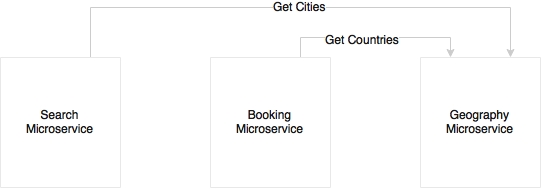
Another approach, as shown in the preceding diagram, is to build it as another microservice. This is good, clean, and neat, but the downside is that every service may need to call the master data multiple times. As shown in the diagram for the Search and Booking example, there are transactional microservices, which use the Geography microservice to access shared data:

Another option is to replicate the data with every microservice. There is no single owner, but each service has its required master data. When there is an update, all the services are updated. This is extremely performance friendly, but one has to duplicate the code in all the services. It is also complex to keep data in sync across all microservices. This approach makes sense if the code base and data is simple or the data is more static.
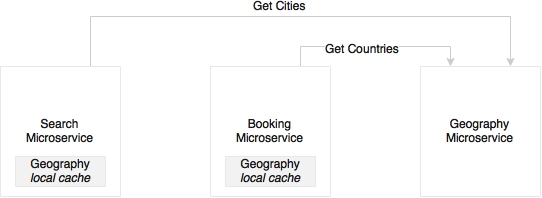
Yet another approach is similar to the first approach, but each service has a local near cache of the required data, which will be loaded incrementally. A local embedded cache such as Ehcache or data grids like Hazelcast or Infinispan could also be used based on the data volumes. This is the most preferred approach for a large number of microservices that have dependency on the master data.
Since we have broken monolithic applications into smaller, focused services, it is no longer possible to use join queries across microservice data stores. This could lead to situations where one service may need many records from other services to perform its function.
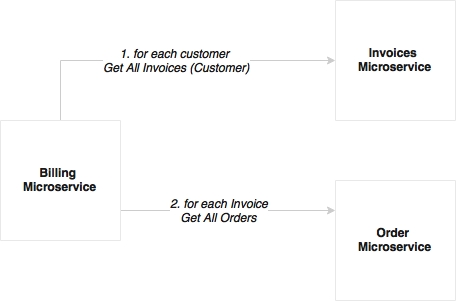
For example, a monthly billing function needs the invoices of many customers to process the billing. To make it a bit more complicated, invoices may have many orders. When we break billing, invoices, and orders into three different microservices, the challenge that arises is that the Billing service has to query the Invoices service for each customer to get all the invoices, and then for each invoice, call the Order service for getting the orders. This is not a good solution, as the number of calls that goes to other microservices are high:
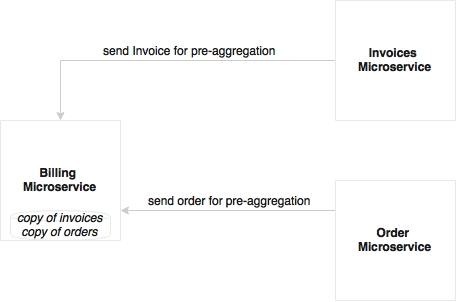
There are two ways we can think about for solving this. The first approach is to pre-aggregate data as and when it is created. When an order is created, an event is sent out. Upon receiving the event, the Billing microservice keeps aggregating data internally for monthly processing. In this case, there is no need for the Billing microservice to go out for processing. The downside of this approach is that there is duplication of data.
A second approach, when pre-aggregation is not possible, is to use batch APIs. In such cases, we call GetAllInvoices, then we use multiple batches, and each batch further uses parallel threads to get orders. Spring Batch is useful in these situations.
